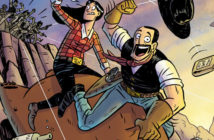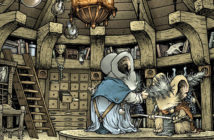The devil’s personal banker of souls is roaming the earth in Aposperos: Merchant of Souls, and he wouldn’t exist if it wasn’t for the artistic imagination of George Martzoukos. Hailing from Athens, Greece, this young talent has joined forces with writer Nektarios Chrissos to create a dark universe of spirituality and fatalism that is unlike anything currently at work in today’s comics industry.
Recently, Broken Frontier’s Steven Surman had the opportunity to talk with Martzoukos about his work on this one-of-a-kind digital comic book.
Steven Surman: Before we even discuss Aposperos, tell me about your artistic work outside of comics.
George Martzoukos: I have been creating art in a professional direction since 2003. My first approach was that of technical excellence over surface texture reflection, as it was the most rare to be found by first glance and obviously the most difficult aspect of drawing from one perspective. This is much related to what I do in Aposperos, but in a different way.
My interest in art evolved due to fantasy art inspirations, when I first saw a few of Luis Royo’s pieces such as “Bifid Chiaroscuro” and “Nine Tongues and One Tear.”
I came across H.R. Giger’s work (of which I have a vast respect for as well) when I was a teenager. But at that point it was in the form of a name, and I didn’t have the time to focus on his work deeply and discover the treasures of his rendering ability. Such bookstores in Greece [that carry these kinds of art books]can be counted on one hand for some reason, and especially at a time when the internet was not yet available.
Later on I discovered Z. Beksinski; I literally found him a little bit after his death from a forum message and was surprised that such an excellent talent for accuracy in representation of such complex formations of light had, for some reason, not met my eyes up to that age and point in my life. In school, we are only taught Delacroix as a painter, you see.
So for some reason, I did not consider painting as a challenge until I saw fantasy art.
My inspiration and inclination in art could be described as a union of flow between deep emotional impacts that I am experiencing from the motivation of surpassing human tragedies or life difficulties, and the spiritual insights that are substantiating these in the form of inner strength and inner power. This is a power that has to bridge our world with realms of the beyond.
My art ranges from science fiction to fantasy renditions, as well as to works that allow abstract aspects of imagery to harmonize with layers of realistic depictions. This allows the perceiver to move back and forth within the art piece and find his own paths of imaginative interpretation within what is offered to him, as a canvas of that universe.
SS: Your artistic vision clearly has a flair for the dark, even the macabre. For example, you’ve mentioned to me in the past that some of your images are inspired a little bit by Clive Barker, most notably of Hellraiser fame. What is it about the darker side of art that attracts you?
GM: In truth, what the dark does is it creates a space for more awareness and more creativity on the infinite level of potential of all nature. This is something that has to be realized from within, against that with is without.
The dark creates more possibilities for light, and gives more room for complexity. I have found dark movies the most geometrically correct in a sense, and at the same time, artistically inspiring. They’re the most interesting aesthetically. You could say that the deeper you go into “visual dimensions”, the more whole you become. On the other hand, the simpler it gets, then the easier it is to create something that is superficial. This is how I would describe my point of view on the dark side of art.
SS: One of the reasons why Aposperos is such an attractive book is because of its unique look. The imagery found within is simply not something seen in everyday comics. What motivated you to work in comics?
GM: Sequential art and storytelling comprise a medium that has greatly interested me for a long time. On a personal level, it combines painting and storytelling, two forms of expression that I love.
I was inspired by Hellspawn initially, illustrated by Ashley Wood at that time, and although I was looking for more and more similar comics to read, I found out that such works of art where very rare. The desire to see more art of that caliber on paper motivated me to draw in a digitally darker manner.
I would like to include as many elements from the medium of comics as possible in my work, and perhaps even in not such a dark manner, but in superhero books in the future. I am beginning to see that this is possible.
And it’s not fair to classify many comic-book adaptations for the big screen as just “for the youngsters.” In that sense, many comic books could have the same professional finish and expanded color pallets and still be comic books and digitally painted works.
For example, in games this has happened as technology evolves. Even if you compare the first Marvel: Ultimate Alliance with the second one, I think that you will notice more colorful depths in the characters’ suits, composition, etc. So I believe that there are always possibilities for such styles as long as it is possible in a logical timeframe.
I especially enjoy the craft of generating emotions out of a particular character’s “symbol” and not just painting for the sake of a mute image. Generally, art has a tendency to do that these days. The mystery of superheroes is a key for maintaining the interest around a book. But I could go on painting, creating on a level where the key of interest changes and this is what is so exciting about Aposperos. The process of creation is my main desire.
SS: Tell me about your specific partnership with writer Nektarios Chrissos of Aposperos. What was it about him and his book that excited you?
GM: Nektarios’ ability direct the plot from multiple viewpoints and time synchronicities, as well as creating various character personalities, it what I love the most about him. He does all of this without restricting the book’s suspense.
But Aposperos give me a wide range of opportunities to use various illustrating and painting styles, all in an effort to represent and unify the different realms that are being depicted.
Because Aposperos (as a character) lives between worlds, between different dimensional realms, an opportunity is given to render the passing points from one dimension to another and this is not something which is traditionally done with a simple bubble around the character carrying him to the next panel. Various methods are used for the eye to soften its focus on the panels where matter loses its solidity around the protagonist—inside the city and where he is moving into the unseen world.
SS: As I alluded to in my review, you bring a unique artistic method to Aposperos. First, tell me about the models you use in the photographic process.
GM: The models are chosen based on their ability to accurately portray the expressions needed. Even if they don’t entirely match what is originally planned, they’re given much freedom as I, too, give much freedom and allow their movement in form and facial expressions.
As long as the model can strongly represent the quality of the personality and emotions of the character he or she is simulating, and as long as their facial characteristics and the general feel that they emanate is on target, that allows me to paint over the expression that I want to finally create. If that happens, then I am fulfilled.
I have to tell you that my first inspiration to work like this was the sequential art on the game Max Payne, specifically the interaction between Mona Sax and Max Payne in the game.
SS: Speaking of photography and models, you yourself are the model for the protagonist, Niko Carris, himself. How was this decision reached?
GM: In the beginning, I didn’t know exactly how my whole artistic process was going to work and allow me to advance further. I had to experiment and build the basis for my technique fast and express the first glimpse of my art instantly, without having to worry about difficulties with the model and trying to explain to them the script or to get them to enter the world first.
For me everything was already there in my mind and I wanted to create a main icon as a source, for how the following pages and future issues would unfold. I also had to be certain, at least for the first issue, that the main character would be represented well enough and that I would have the time and ability to go back and make last-minute changes.
I also had enough confidence in myself as a model for Aposperos, and so I took the challenge upon my own shoulders, even though I never had any professional acting or modeling experience.
SS: Once you’re finished with the photographs, you paint them digitally, giving them an ethereal look. Tell us about this, such as the details of your technique and your inspiration/thought process behind them.
GM: Yes, as you alluded to in your review, the photos are transferred onto the computer. Then, their opacity is brought down (most of the time) so that they become transparent. Different layers of scanned oil or acrylic paints and pigments (in their different parts) are either placed in transparency over the photo or below it.
Then I start emphasizing by dodging and burning color, and enriching or switching general color tones, or transferring parts of the scanned abstract pigment on different parts of the photo selectively. For example, take the face or the body of a model in a photograph; this is selected by key spots, so as to repaint the whole image by working in between two or even more layers.
I create focus points from where I can lead the eye into gaining more attention on the panel and where all the aspects that have to be expressed actually are, while cinematically the eye moves within the flow of emotion and form. But at the same time, the general theme of the book cannot be overshadowed (such as the time-era in which the story is currently based, as it is being recognized by the surrounding scenery, for example).
Once it is more or less completed, I work on the next panel. Few panels are digital painting out of reference. This was initially done for the first pages but was later avoided.
SS: One element of the comic-creating process that I’m endlessly interested in is the script of the writer and how it’s handled by the artist. Does Aposperos writer Nektarios give you a heavy script that you closely follow, or does he allow you a lot of creative elbow room?
GM: The writer allows me logical freedom but not chaotic freedom. Nektarios trusts what I feel and what I do. The script is demanding, and this is what I, too, wanted it to be.
But in terms of direction, for example, if I happen to have a photo for a panel which is looking better aesthetically than another one (but the difference is that of a slight variation in the camera’s angle, from the one that was expected in the script) then of course the better photo is chosen, in that sense.
Of course, for the unseen world that’s in the story I am free to keep a balance between mystery and realism.
SS: This is a question that I’ve also asked Nektarios, but I’d like you input too: Even though Aposperos is currently being published as a digital comic, would you like to see it in hard print at some point, such as a trade paperback?
GM: Yes, of course! I would love that, but not necessarily for myself out of some need to have it in print and in my bookcase, but in order for it to reach more people and gain the place it deserves in bookstores as a series.
I believe that it has its audience, but it has not fully reached it yet and at some point I would love to see a printing happen.
SS: From an artistic standpoint, what can you tell us about the future of Aposperos?
GM: Although it is physically a very demanding project, it gives me so much in return that I would like to see it expand more and more.
What I can say is that the unseen world will be enriched with original Geometrical-apocalyptic renderings within full sceneries, probably coming from ZBrush (digital sculpting software). This is like something readers have not seen yet!
This is just the beginning of a thrilling series with much more at work than is currently there.
The staff of Broken Frontier would like to thank George Martzoukos for taking the time to discuss Aposperos: Merchant of Souls and his work on it.
For more information, please visit Visionary Comics. And to purchase the first issue of Aposperos: Merchant of Souls, please visit Drive-Thru Comics, where the book is available for digital download at the low price of $1.49.
This interview originally appeared on Broken Frontier.




